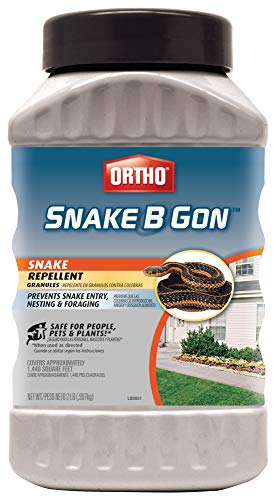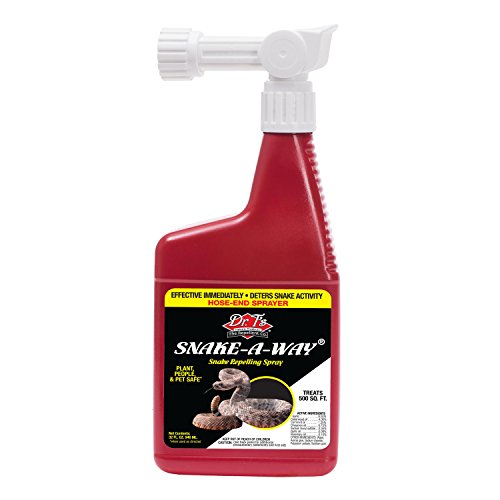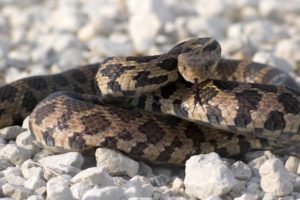Best Snake Repellent
DID YOU KNOW?
Snakes prefer damp, cool, dark areas and are known to make nests near the lowest levels of homes.
Take preventive steps to protect yourself from a snake infestation.
The Best Snake Repellent
It’s understandable if you want to get rid of snakes in your home or yard fast, especially if you have ophidiophobia—fear of snakes. The Centers for Disease Control and Prevention (CDC) estimate that up to 7,000–8,000 people per year receive venomous bites, 1,300 of those are children. Fortunately, most of these bites are minor, with fatalities happening roughly five times a year. Aside from the fright and pain of being bitten, there are other significant concerns; like bacterial infections, the cost of trips to the Emergency Room; residual fear of outdoors, and of course, the danger to your pets. These concerns make finding the best snake repellent a top priority if you’ve spotted one. However, there’s more to getting rid of them permanently.
Continue reading to learn what you need to know about t and what keeps snakes away from your house.
Snake Repellent We Reviewed
How We Found the Best Snake Repellent
8 Reviewers
26 Products Considered
3 Products Reviewed
3 Top Picks
Snake Problem?

Ortho Snake B Gon Snake Repellent
Pros
- Affordable
- The outstanding reputation of the manufacturer
- Safe to use around children and pets
- Non-toxic for the environment
- Humane solution
Cons
- Have to reapply if it rains
- Mixed results with different species of snakes
OUR VERDICT
Ortho Snake B Gon Snake Repellent offers an inexpensive and safe way to repel snakes with its effectiveness varying with the species
Our Review
Ortho Snake B Gon Snake Repellent uses a potent mix of essential oils including peppermint and clove to ward off pests. The concentration of these ingredients isn’t harmful to people, pets, or the environment. It works by interfering with a snake’s ability to get around in its habitat and identify possible threats. This vulnerability leads the reptile to move elsewhere and off your property.
The product is easy to use wherever you’ve seen activity or signs of a snake. While the essential oils are generally safe, you shouldn’t apply it to food that you’ll eat. The two-pound container covers a lot of ground, making it an excellent value too.
article continues below

Dr. T’s Snake Repellent
Pros
- A humane solution that won’t hurt the snakes
- Excellent penetration
- Safe to the environment
- Third-party tested
- Not harmful to children
Cons
- More expensive than other options
- Have to reapply after heavy rains
OUR VERDICT
Dr. T’s Snake Repellent acts by disrupting the reptiles’ sensory perception of their environment to create a threatening situation they’ll avoid.
Our Review
Dr. T’s Snake Repellent uses a different blend of essential oils than the Ortho Snake B Gon Snake Repellent. It includes ones like garlic which some may find offensive. You apply it by attaching the 32-ounce bottle to a garden hose. You can use it as a barrier treatment around the perimeter of your yard or places where you’ve seen signs of activity.
While it’s safe to use in your garden, avoid spraying directly on any plants, especially those you intend to eat. You should refrain from using it if you have pets that spend time outdoors where you’ve seen snakes because of its toxicity to both cats and dogs.
Introduction to Snakes
Over 30 percent of people fear all snakes although only 20 species of venomous snakes live in the US. Most are non-aggressive unless cornered or startled, preferring to avoid encounters with people. You’ll find these reptiles on almost every continent on the planet, except Antarctica. They are cold-blooded or ectotherms. That means their body temperature is that of the ambient conditions.
As it gets warmer, snakes get more active and vice versa. That’s one reason why you may see them on pavement or the trail on sunny fall days. Unlike bears, they don’t hibernate. They stay awake during the winter months but are sluggish at best. There are over 3,600 species with most in tropical and subtropical regions.
The diet of snakes varies with the kind. They eat a broad range of prey from insects to fish to rodents. Some even feed on other reptiles. Their biology is unique to this class of animals. They have no legs but instead, rely on their muscles to move around in their environment. They swallow their food whole. They use stealth to stalk and strike quickly. They also don’t have eyelids or ears.
What You Need to Know
There are just over 300 species of snakes in the United States, 20 of which are venomous. Venomous snakes fall into four basic groups: Rattlesnakes, Copperheads, Coral Snakes and Cottonmouths (Water Moccasins). Before you tackle this issue, it’s imperative to know how to identify the dangerous species.
Venomous species have pits on both sides of their triangular heads between their nostrils and their eyes. They also have vertical pupils versus the round ones of non-venomous snakes. There are also classic traits like the rattle of the rattlesnake and the red, yellow, and black bands of the coral snake. Temperament varies with the type. An aggressive snake isn’t necessarily poisonous.
For example, the brown water snake is not venomous. However, it will strike without provocation. What makes them dangerous is the bacteria that exists in their mouths. If the bite doesn’t hurt you, the resulting infection will. It’s essential to clean any wounds thoroughly to prevent complications.
Signs of a Snake
If you don’t see the snake, there are other telltale signs that you have one. You may find their tracks in loose soil or sand. You may also find shedded skins from molting. They are thin and have the distinctive scale pattern on them. Their skin doesn’t grow, making this process essential as snakes get larger.
Preventing a Snake Problem
Discouraging these reptiles with products like Ortho Snake B Gon Snake Repellent or Dr. T’s Snake Repellent is an excellent start. You’ll avoid the hassle of trying to find their den or the risk of them getting into your house. The latter limits your options for controlling them. The best way to halt an issue in its tracks is to make your home and yard inhospitable and inaccessible to these pests.
Snakes don’t like venturing into open spaces. They prefer the shelter and safety of cover. Trimming vegetation around your house and outbuildings removes this resource. You should also get rid of any woodpiles that can provide a safe place for them to hide. However, you should proceed cautiously because a threatened animal will strike.
Aromatic repellents are effective for deterring snakes. These reptiles rely on smell to locate their prey. They also pick up particles in the air using their forked tongues that they rub along a structure in their mouths called the Jacobsen’s organ. When you use a product with a strong scent, it interferes with its function, leaving them vulnerable. The snake will vacate the area quickly for safety.
Getting Rid of Snakes
If you need to remove the animal, it’s a different matter. Some areas protect some reptiles such as timber rattlesnakes because of their federal or state threatened or endangered status. However, you can kill a venomous animal if you feel threatened. However, you must document the incident and report it to the proper agency.
If it is a venomous snake, you should contact your state Department of Natural Resources (DNR) or local extension service. These cases require a professional to take care of the intruder.
Summary
Having a snake in your home or yard is disconcerting for many people. However, the best snake repellent and other measures can protect your home and keep it pest-free. As with other nuisance wildlife, that means removing the essentials like food and shelter to discourage them. Bear in mind that you must continue with these tasks if you live in this reptile’s habitat.




